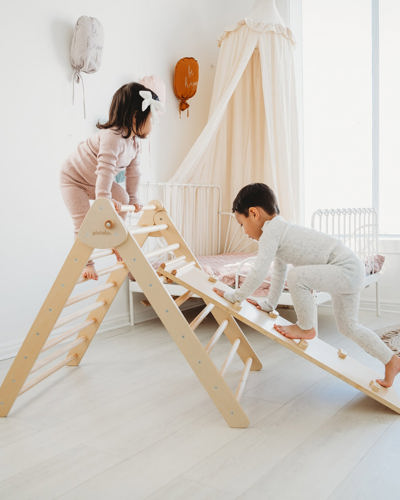
From the first time you walk into the nursery and find your baby standing in their crib you know things are about to get a lot more stressful exciting. Your blissful days of the potted plant phase are over and you’ve now entered the seemingly endless “climb all the things” era.
Of course climbing and taking risks is an important part of baby and child development. The trick is finding the right tools and toys to safely build those skills. There are many different toddler climbing toys that fit the bill, but few have become as ubiquitous as the Pikler triangle.
What is a Pikler triangle?
If you’ve got a toddler, chances are you’ve already come across a Pikler triangle (also referred to more broadly as a climbing triangle) at play group or preschool. A piece of play equipment that’s typically made of wood and (not surprisingly) shaped like a triangle, these climbers look like a V-shaped ladder with rungs on both sides. The wide base ensures it’s sturdy enough that it won’t get tipped during play time, and rounded edges make it safer for tiny daredevils. While it’s used in many Montessori learning environments and aligned with the Montessori philosophy, it’s not traditionally considered a Montessori toy.
Benefits of a Pikler triangle
If you’ve ever been cooped up with an active toddler, you know there’s nothing better than a toy that helps them burn off energy. And a climbing triangle definitely fits that bill. But it also offers so much more. According to Juli Williams, a Montessori educator, “We use the Pikler triangle to work on refinement of equilibrium; how to stand, step, balance, climb, reach, pull and step down from the climbing structure.” It’s an ideal tool to help them develop gross motor skills as they climb up and down, perch themselves on top, or simply play and explore.

In addition to its physical benefits, a Pikler triangle can also provide children with a sense of independence and confidence as they explore and play on their own. The open design allows for free and creative play, helping children to develop their imagination and problem-solving skills.
Who invented the Pikler triangle?
Named after Emmi Pikler, a Hungarian pediatrician and early childhood educator who developed the concept of “free play” as an important aspect of children’s development, she first introduced it at an orphanage in the 1940s.
Similar to the Montessori philosophy, Pikler believed it was important for babies and young children to explore and play without interference from adults. She also felt that babies are perfectly capable of entertaining themselves and that they shouldn’t be put into a position they couldn’t access on their own.
According to Pikler, “Whilst learning to turn on the belly, to roll, creep, sit, stand and walk, (the baby) is not only learning those movements but also how to learn. They learn to do something on their own, to try out, to experiment. They learn to overcome difficulties. They become to know joy and satisfaction derived from this success, the result of their patience and persistence”.
When to introduce a Pikler triangle
One of the best things about climbing triangles is their inherent grow-with-me design. At the earliest ages it can be used like a play gym with baby underneath and toys suspended above. When they get a bit stronger, let the real fun begin!
“We like to introduce these climbing structures preferably when a child is a confident walker. However, babies around 9-12 months can benefit from them as well as it can work well as a pull up structure. However, it is very important that younger babies and toddlers are supervised when using this structure as many children can begin to climb it but may lack the skill of successfully climbing down independently,” says Williams.
It is important to keep in mind that every child develops differently, and the age range for using a Pikler triangle is just a general guideline. Some children may be able to start using it at an earlier age, while others may need more time to develop the necessary skills. The key is to make sure that the child is physically and developmentally ready to use the equipment, and to always supervise and assist as needed.
How to choose the best Pikler triangle
William’s suggestion is simple. “When looking for a climbing structure it is crucial that you purchase from a reputable brand, as it is so important that these structures are well designed and safe for children to climb on. Always check for the weight recommendations and make sure that your children are within the weight range recommended to use.”
Piccalio
Mini Climber Pikler Triangle Set
From the makers of our favorite convertible learning tower, every aspect of the Piccalio Mini Climber Pikler Triangle Set is designed to help little climbers learn and grow. From the well-proportioned dimensions that make it easy and safe to explore to the dual top rung system which offers extra stability when they reach the peak, there’s absolutely nothing we’d change about it! What’s more, the included reversible ramp gives them even more ways to play. On one side, they’ll find a rock wall to work on their scrappier climbing skills. On the other, a smooth slide to come back down.
Shop now:https://piccalio.com/
